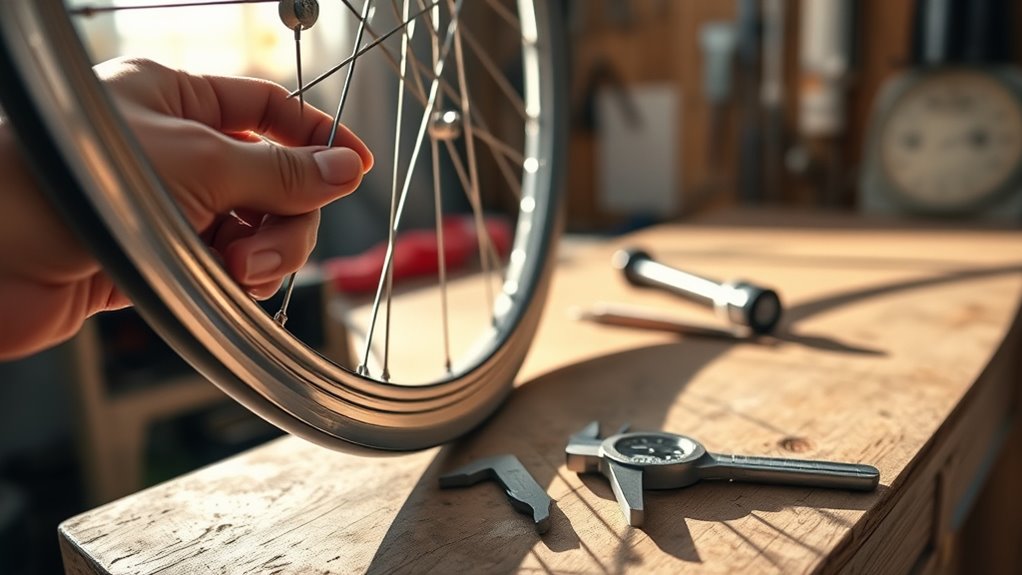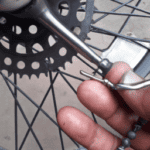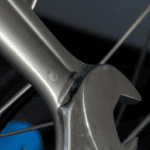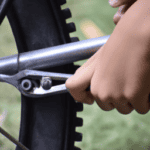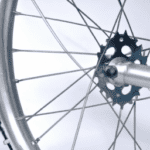To spot a wobbly bike wheel, spin it and check for side-to-side or up-and-down motion near the brakes. Grip the spokes to test their tension and look for any missing ones. If you find loose spokes or uneven tension, tighten them using a spoke wrench. Inspect for damage, like bends or cracks in the rim. Proper tire bead seating is essential too. There’s plenty more to know to keep your wheels in top shape!
Key Takeaways
- Spin the wheel to check for side-to-side or up-and-down motion and observe rim proximity to brakes.
- Inspect spoke tension by gripping spokes; tighten any loose spokes to maintain stability.
- Ensure tire bead is properly seated in the rim and check for proper alignment.
- Use a truing stand to identify high spots or irregularities in the rim’s shape.
- Regularly monitor wheel condition and check for loose hub bearings to eliminate axle play.
Identifying Wobbling in Your Rear Wheel
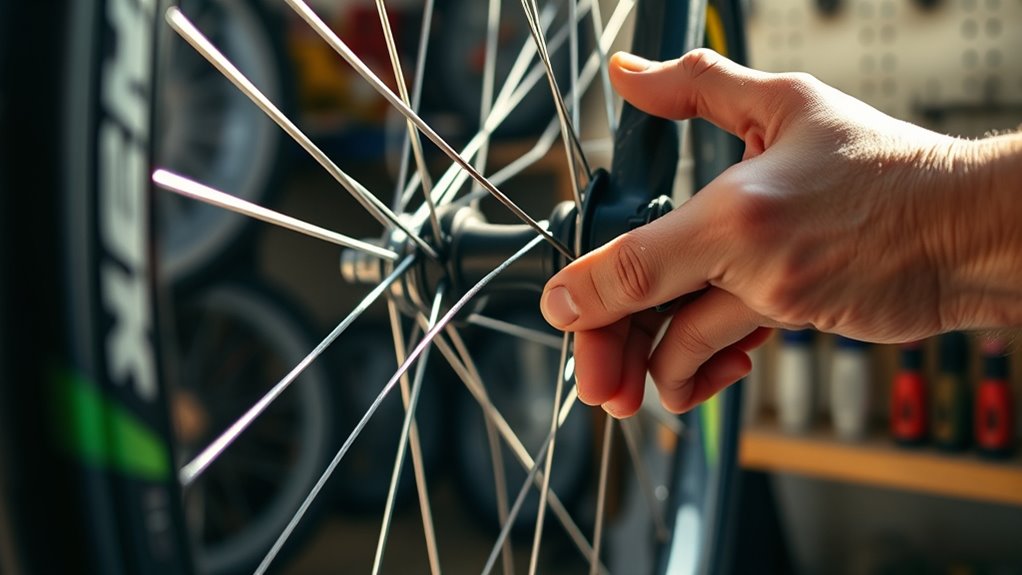
Have you ever noticed your rear bike wheel wobbling? Identifying a wobbly rear wheel is essential for safe riding. Start by spinning the wheel and observing how close the rim gets to the brakes. Any side-to-side or up-and-down motion indicates a problem.
Pay attention to misalignment between the tire and seat stays or brake shoes, which can also signal wobbling issues. Grip the spokes around the problem area to check for loose or uneven tension, as this can worsen the wobble.
Finally, inspect for missing spokes or damaged components like the axle. Regular maintenance and prompt adjustments can prevent further wobbling, ensuring a smoother and safer ride. Furthermore, maintaining proper color accuracy in your bike’s components can also enhance overall performance and safety.
Common Causes of a Wobbly Bike Wheel
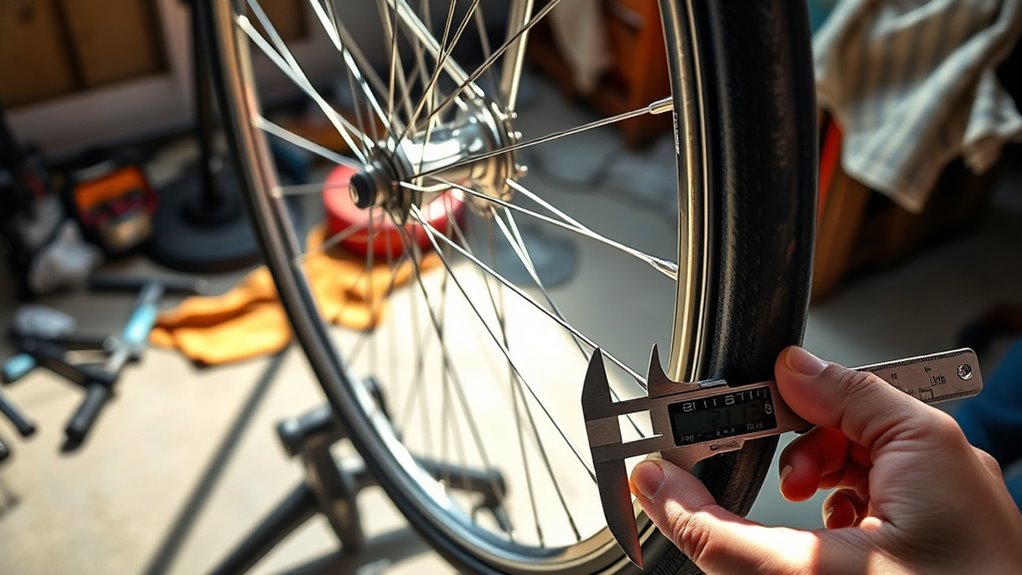
A wobbly bike wheel can stem from several common issues that affect your ride’s stability and safety. One major cause is loose hub bearings, which create play in the axle, leading to instability while riding.
Additionally, uneven spoke tension can result in a buckled wheel, causing it to wobble side-to-side or up-and-down. Missing spokes considerably contribute to imbalances in the wheel structure, making it essential to address this issue with replacements and proper tension adjustment.
Damaged wheels, including bent rims or broken axles, can also lead to uneven tire contact, so inspect for visible damage.
Finally, improperly mounted tires, where the bead isn’t fully engaged with the rim, can contribute to a wobbly wheel, making a seating check necessary. Furthermore, regular maintenance can mitigate issues and enhance overall bike performance.
Checking Spoke Tension and Adjustments
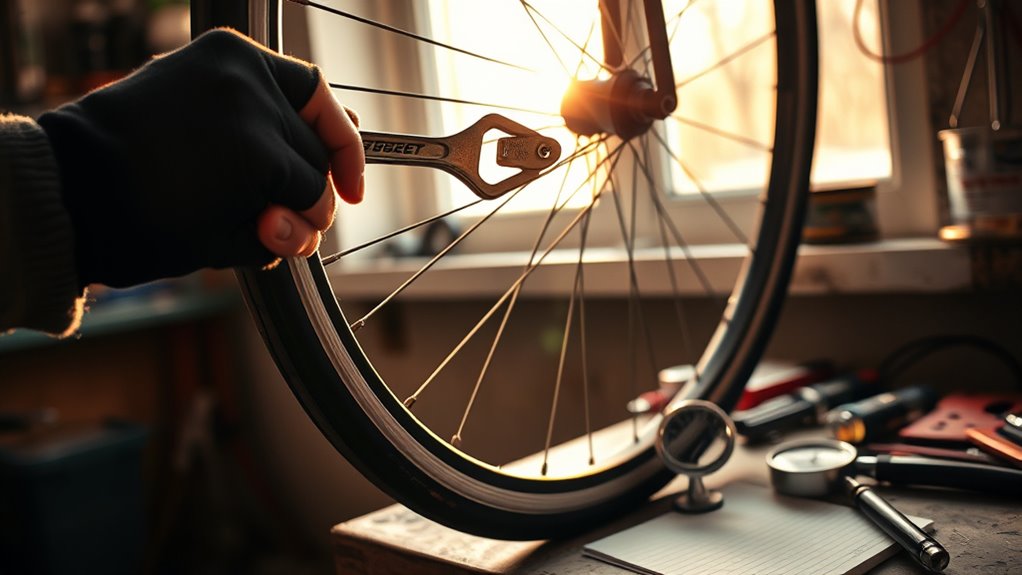
To fix your wobbly bike wheel, start by checking the spoke tension around the problem area.
You’ll want to compare the tightness of those spokes to the ones on the opposite side for a balanced adjustment.
Making precise tweaks will help guarantee your wheel stays true and smooth. Additionally, ensuring that your wheel is properly aligned with the correct spoke tension is crucial for optimal performance and longevity.
Assessing Spoke Tightness
While inspecting your bike wheel for wobbles, evaluating spoke tightness is essential for ensuring a smooth ride.
Here’s how to assess spoke tightness effectively:
- Grip the spokes around the problem area to check for looseness compared to surrounding spokes.
- Use a spoke tension meter to measure all spoke tensions, ensuring they align with your wheel’s specifications.
- Identify loose spokes by comparing their tension with spokes on the opposite side for balance.
- Regularly monitor spoke tension and make incremental adjustments to avoid over-tightening.
Additionally, maintaining proper spoke tension can help prevent issues similar to those seen in car tuning where performance can decline due to neglect.
Adjusting Spoke Tension
Three key steps will help you effectively adjust spoke tension and fix that wobbly bike wheel.
First, grip the spokes around the problem area and compare their tightness to those on the opposite side. If you find any loose spokes, it’s time to use a spoke wrench. Make small half-turn adjustments to tighten them, being careful not to over-tighten, which can lead to further misalignment.
Next, regularly monitor the tension during the truing process; spin the wheel after each adjustment to check your progress. If a spoke feels noticeably loose, tighten it to match the surrounding spokes.
For precision, consider using a spoke tension meter to guarantee ideal tension levels and improve your wheel’s performance and stability. Additionally, ensure that your bike is equipped with disc brakes for better stopping power to enhance overall safety during rides.
Balancing Tension Across Wheel
After adjusting spoke tension, it’s important to verify that the tension is balanced across the wheel. Here’s how to ensure that:
- Grip the spokes around the problem area to check for looseness compared to adjacent spokes.
- Mark wobbling spots on the rim with a permanent marker or masking tape for targeted adjustments.
- Tighten the affected spoke by making a half-turn clockwise with a spoke wrench, while loosening adjacent spokes with quarter-turns to maintain balanced tension across the wheel.
- Compare tension levels with the opposite wheel regularly to verify consistency.
Additionally, maintaining proper spoke tension can help in extending tire longevity and enhancing overall ride quality.
Inspecting the Wheel for Damage

Inspecting your bike wheel for damage is essential to maintaining a smooth ride. Start by spinning the wheel and looking for any lateral or radial wobbling, and check for visible high spots or irregularities in the rim‘s shape.
Use a spoke wrench to tighten any loose spokes, as even one broken spoke can drastically impact wheel stability. Next, examine the rim for dents, cracks, or other signs of damage that could compromise its structural integrity.
Don’t forget to inspect the hub for play in the axle; loose bearings can lead to wobbling and should be tightened. Finally, verify the tire bead is fully seated on the rim to avoid wobbling and enhance overall performance. Additionally, ensuring you have a well-defined budget plan can help you allocate funds for necessary bike repairs or upgrades.
Understanding Axle and Hub Issues

Understanding the axle and hub issues is essential for maintaining a stable bike wheel, especially since loose components can lead to wobbly rides.
Understanding axle and hub issues is crucial for a stable bike wheel, as loose components can result in wobbly rides.
Here are key areas to check:
- Cup-and-cone bearings: Loose bearings can create play in the axle, causing instability.
- Tighten hub cone nuts: Properly tightening these can eliminate axle play and enhance stability.
- Inspect the axle: Look for bends or damage. A bent axle leads to uneven tire contact and wobbling.
- Check for wear: Regularly inspect the hub for worn cup-and-cone bearings and replace them to prevent wobbling issues. Additionally, ensuring proper airflow around the wheel can help maintain overall bike performance.
Ensuring Proper Tire Mounting
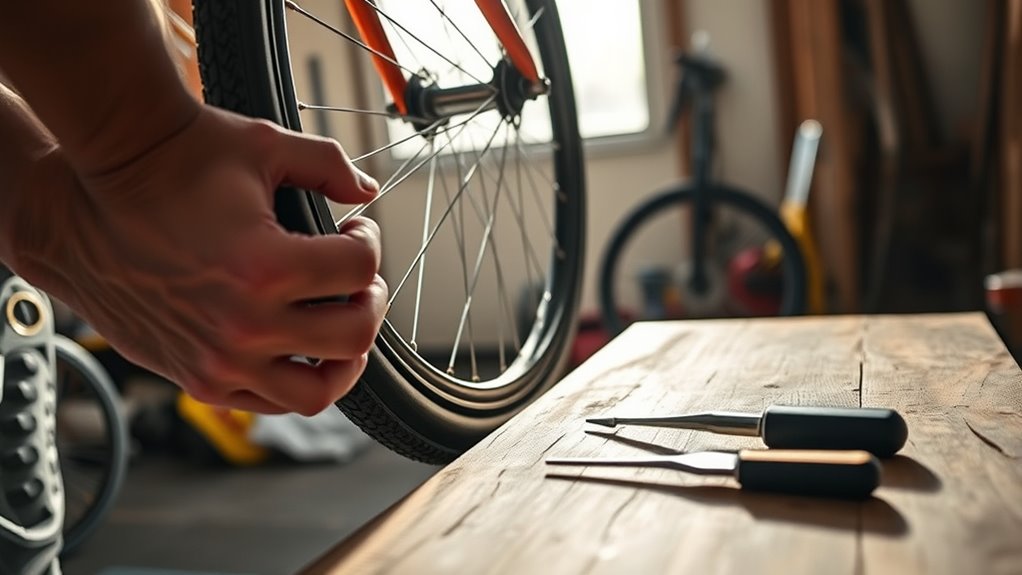
To guarantee your tire’s mounted correctly, start by checking that the bead is fully seated in the rim.
Inflate the tire to the recommended pressure and observe its alignment while spinning the wheel.
Catching any issues early can save you from a wobbly ride later on. Additionally, ensuring proper tire mounting can enhance your bike’s overall electric bike performance, especially when riding on varied terrains.
Tire Bead Engagement
Ensuring your tire bead is properly mounted is essential for a smooth ride, as a snug fit against the rim helps prevent wobbling.
To check your tire bead engagement, follow these steps:
- Inspect the entire circumference of the tire for even alignment and gaps between the tire and rim.
- Spin the wheel and observe if the tire remains consistently in line with the rim without noticeable bulges or misalignments.
- If you notice any issues, deflate the tire and push the bead into the rim.
- Reinstate the air slowly while checking for proper seating.
Regularly inspect the tire bead engagement after installation or if you encounter handling problems, as improper seating can lead to wobbling and safety hazards. Additionally, maintaining payment security features can help prevent financial mishaps while managing your bike repairs.
Checking Rim Alignment
Before you hit the road, it’s crucial to check your rim alignment, as improper mounting can lead to a wobbly ride.
Start by flipping your bike upside down or using a truing stand for easy access. Spin the wheel and watch for any wobbling, noting areas where the rim strays from a straight line. This may indicate improper tire mounting or an untrue rim.
Use your rim brake calipers to gauge trueness; a properly mounted tire shouldn’t rub against the pads as it spins. Also, verify the tire bead is fully seated and evenly positioned around the rim.
Regularly inspect both the tire and rim for any visible damage or wear, as this can impact alignment and contribute to wobbling.
Proper Inflation Pressure
Proper tire inflation pressure is essential for keeping your bike stable and preventing that annoying wobble.
To confirm your tires are properly inflated and mounted, follow these steps:
- Check Manufacturer’s Specs: Find the recommended PSI on the tire sidewall.
- Use a Reliable Gauge: Regularly measure tire pressure, as small deviations can impact handling.
- Inspect Tire Bead: Before inflating, verify the tire bead is seated evenly on the rim.
- Monitor for Damage: Check for pinch flats or any signs of tire wear regularly.
Maintaining proper inflation pressure not only enhances your ride quality but also minimizes the risk of tire damage.
Staying on top of these checks will keep your bike in peak shape and free from wobbles.
Tools Needed for Wheel Truing
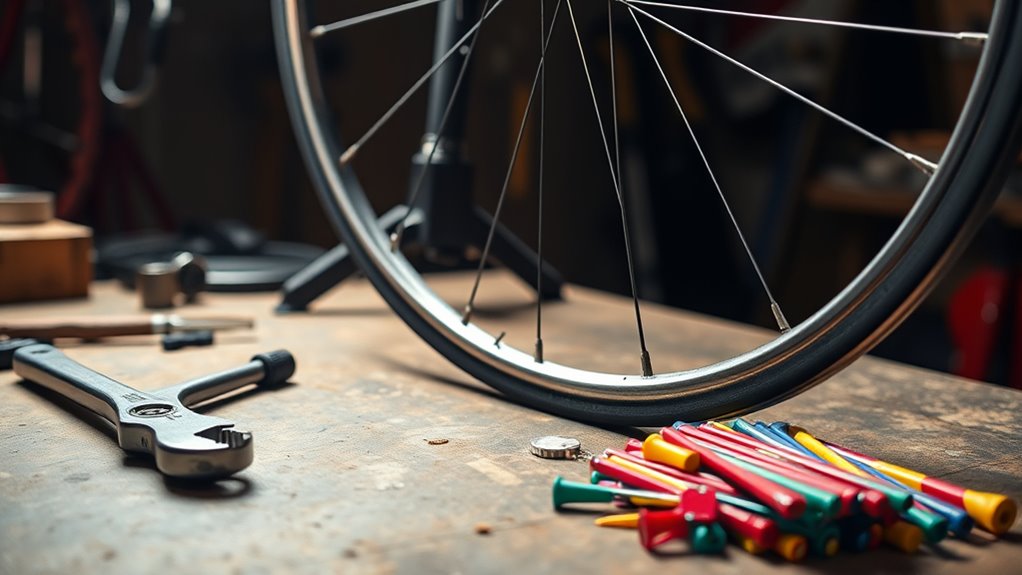
Truing a wobbly bike wheel requires the right tools to get the job done effectively.
First and foremost, you’ll need a spoke wrench, specifically the correct size for your spokes, to make precise adjustments without damaging the spoke nipples. A truing stand can greatly enhance your accuracy, but flipping your bike upside down works too.
To true a bike wheel, a correctly sized spoke wrench is essential for precise adjustments, and a truing stand ensures accuracy.
To assess the rim’s trueness, use calipers or markers to identify high spots or areas needing adjustment. Tire levers may come in handy if you need to remove the tire, preventing damage during the process.
Finally, a permanent marker or masking tape can help you mark wobbly points on the rim, giving you a clear visual reference for adjustments.
Step-by-Step Guide to Truing a Wheel
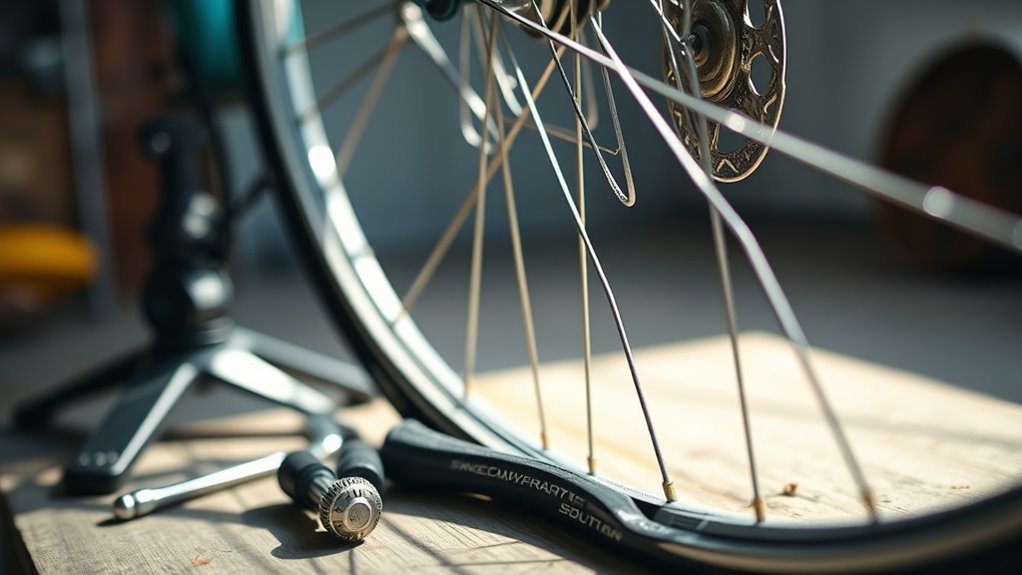
To get started on fixing that wobbly wheel, you’ll want to flip your bike upside down or set it up in a truing stand.
Follow these steps to true your wheel effectively:
- Mark any wobbly spots on the rim with a permanent marker for easy identification.
- Grip the spokes around the wobble, checking for looseness, then tighten the affected spoke with a half-turn clockwise.
- Loosen adjacent spokes with quarter-turns to balance tensions.
- Spin the wheel after each adjustment to monitor progress, making incremental tweaks until the wobble is gone.
If you spot any high spots, tighten the adjacent spokes accordingly.
Keep checking for improvements, adjusting multiple spokes rather than relying on one.
Happy truing!
Regular Maintenance Tips for Wheel Integrity
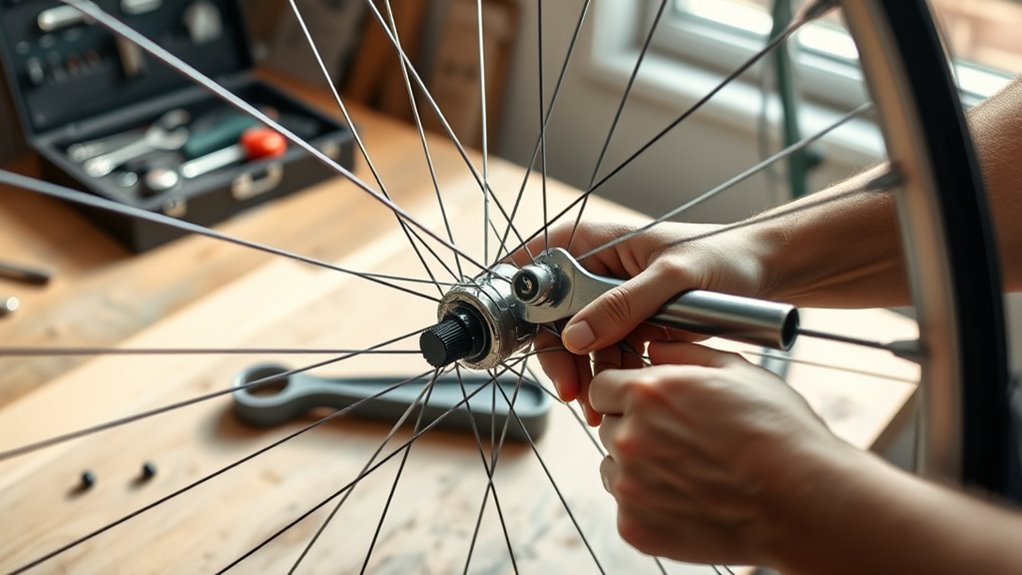
Maintaining your bike wheels is just as important as truing them. Regularly inspect spoke tension by comparing it with the opposite wheel to guarantee balanced support and prevent wobbling. Use a spoke wrench to tighten any loose spokes you find during your checks.
After crashes or rough rides, monitor your wheel’s condition for misalignment or damage that can affect stability. A spoke tension meter can help you check for proper tension levels, avoiding uneven wear and future wobbling issues.
Don’t forget to check for loose hub bearings as well; maintaining tight axle cone nuts eliminates play that contributes to wobbling. Schedule consistent maintenance checks, including truing the wheel and inspecting for missing spokes, to guarantee long-term wheel integrity and performance.
Community Experiences and Repair Insights
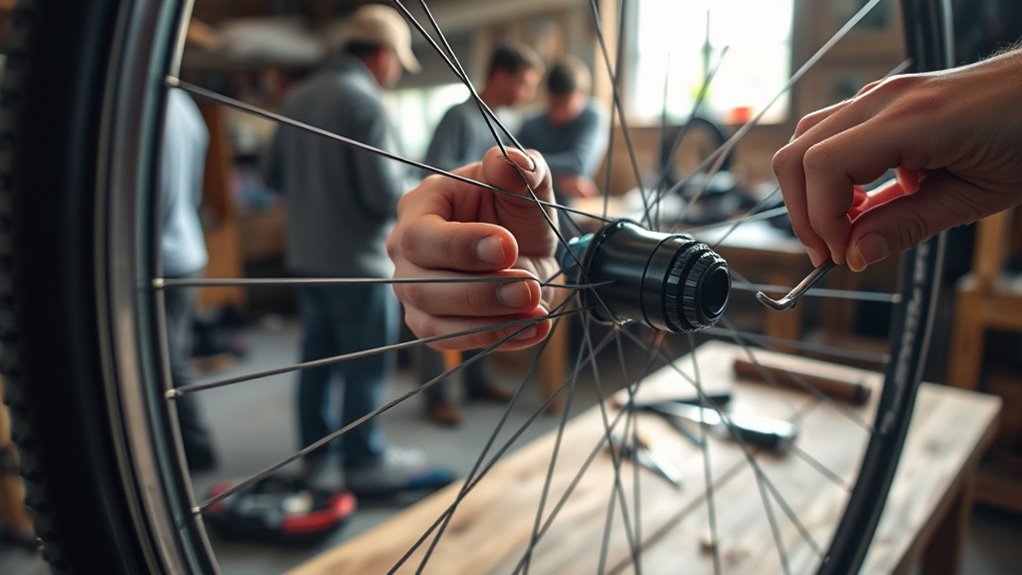
You’ve probably heard from fellow cyclists about their successful DIY repairs for wobbly wheels, often starting with tightening loose axle nuts.
Many have found that inspecting dropouts and ensuring tire beads are seated properly can make a big difference.
Successful DIY Repairs
Many cyclists have successfully tackled wobbly bike wheels through simple DIY repairs, sharing their insights and experiences within the community.
Here are some effective tips to help you restore wheel stability:
- Tighten axle nuts – Confirm they’re secure to prevent wobbling.
- Inspect dropouts – Look for any loosening, as this can contribute to instability.
- Engage tire bead – Properly align the tire on the rim to eliminate misalignment issues.
- Use a spoke wrench – Adjust spoke tension or tighten bearings as quick fixes to restore balance.
Community feedback emphasizes that regular maintenance and these quick DIY repairs can prevent future wobbling, making your rides smoother and more enjoyable.
Stay proactive with your bike care!
Common Wobbling Causes
Wobbly bike wheels can be a frustrating issue for cyclists, but understanding their common causes can lead to effective solutions.
One prevalent cause is loose axle nuts; many cyclists have resolved their wobbling issues simply by tightening them.
Another common culprit is improperly tensioned or missing spokes, which can create imbalances in the wheel. Replacing spokes and using a wheel truing stand can fix this.
Additionally, verify the tire bead is properly engaged with the rim, as improperly mounted tires can cause wobbling too.
Regularly inspect for bent or damaged rims and axles, as these can lead to uneven tire contact.
Finally, tightening hub cone nuts can eliminate play in the axle, enhancing the stability of your rear wheel during rides.
Effective Maintenance Tips
While maintaining your bike, it’s crucial to address potential issues before they escalate into bigger problems. Here are some effective maintenance tips that can help you keep your wheels wobble-free:
- Regularly inspect and tighten loose axle nuts; many cyclists find this common fix to be effective.
- Verify your tire bead is properly seated with the rim; a correctly positioned tire can eliminate wobbling.
- Use a spoke wrench to adjust any loose spokes and maintain ideal tension, preventing imbalances.
- Check for missing spokes and hub play during routine maintenance to catch issues early.
Sharing your repair experiences with the cycling community can also inspire others to tackle similar problems, making DIY fixes accessible for everyone.
Frequently Asked Questions
How to Fix a Wobbly Wheel on a Bike?
To fix a wobbly wheel on your bike, start by flipping it upside down or using a truing stand.
Check the rim’s alignment relative to the brakes. Mark any bends with a permanent marker, then compare spoke tension.
Tighten the affected spoke a half-turn clockwise, loosening adjacent spokes slightly to keep balance.
Spin the wheel after each adjustment to track progress, making small tweaks until the wobble’s gone.
Regularly inspect for other issues too!
How to Fix Wobble in a Wheel?
So, you’ve got a wobbly wheel, huh? It’s like your bike’s auditioning for a circus act.
To fix it, first, check how much it wobbles. Use a spoke wrench to tighten any loose spokes, turning them a half turn, and loosen nearby ones to keep things balanced.
Spin the wheel after each adjustment to see if it’s behaving. Keep at it until your bike’s ready for a smooth ride again—no clowning around!
How Do You Realign a Bike Wheel?
To realign a bike wheel, start by flipping your bike upside down or using a truing stand for better access.
Check the rim’s alignment by observing its proximity to the brakes, marking any wobbly spots.
Adjust the spoke tension by tightening the affected spoke while loosening adjacent ones to maintain balance.
Spin the wheel after each adjustment until you see improvement.
Regularly monitor spoke tension to keep your ride stable and wobble-free.
What Causes the Front Wheel on My Bike to Wobble?
Did you know that nearly 20% of cyclists have experienced issues with their bike wheels?
When your front wheel wobbles, it’s often due to loose hub bearings, improperly tensioned spokes, or a bent rim.
You might also find misaligned tire beads or damaged axles contributing to the problem.
Regular inspections can help you catch these issues early, ensuring a smoother, safer ride every time you hit the road.
Conclusion
In the grand adventure of cycling, a wobbly wheel can feel like a pesky little gremlin trying to spoil the ride. But with a bit of patience and the right tools, you can send that gremlin packing! By keeping your wheels true and giving them regular TLC, you’ll guarantee smooth sailing on every journey. So hop on your bike, embrace the joy of the ride, and let your wheels spin with confidence! Happy cycling!
